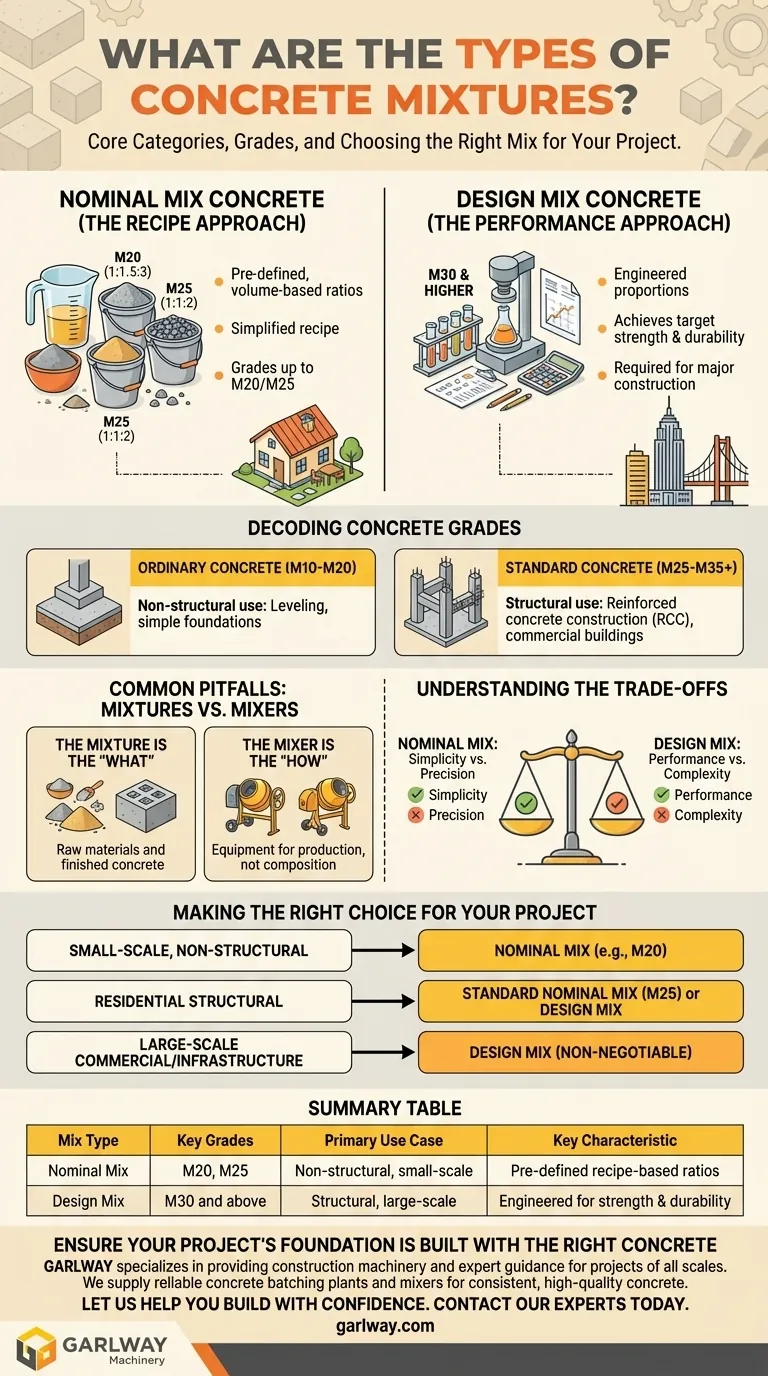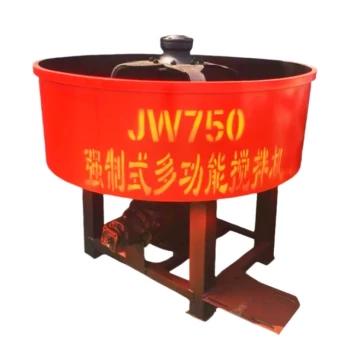At its core, concrete mixtures are primarily categorized by their compressive strength, known as a "grade," and the method used to determine their ingredient proportions. These grades are broadly grouped into Nominal Mixes, which follow a pre-defined recipe, and Design Mixes, which are engineered for specific performance requirements.
The most critical distinction is not just the grade, but the philosophy behind it: choosing between a standardized, recipe-based Nominal Mix for general use and a performance-engineered Design Mix for critical structural applications.

The Two Core Categories of Concrete Mixes
The fundamental difference in concrete mixtures comes down to how their proportions are determined. This choice dictates the reliability, performance, and application of the final product.
Nominal Mix Concrete (The Recipe Approach)
A Nominal Mix uses pre-determined, volume-based ratios of cement, sand, and aggregates. This is a simplified, recipe-based approach.
These mixes are designated by grades like M20 or M25. The letter "M" stands for Mix, while the number indicates the compressive strength in Newtons per square millimeter (N/mm²) after 28 days.
For example, an M20 grade typically uses a ratio of 1:1.5:3 (1 part cement, 1.5 parts sand, 3 parts coarse aggregates). An M25 grade uses a ratio of 1:1:2.
Design Mix Concrete (The Performance Approach)
A Design Mix is one where the proportions are not pre-defined. Instead, they are specifically calculated and engineered by a professional to achieve a target strength and durability.
Grades like M30 and higher are almost always Design Mixes. They require lab testing of materials to create an optimized, economical, and reliable formula for demanding applications.
This approach is necessary for major construction projects where specific performance characteristics are a critical engineering requirement.
Decoding Concrete Grades
Concrete grades provide a clear shorthand for a mixture's strength and intended use. They are generally split into two main classifications.
Ordinary Concrete
This category typically includes grades up to M20. It's suitable for non-structural work where high strength is not the primary concern.
Common uses include leveling, simple foundations for non-load-bearing walls, and residential floor slabs.
Standard Concrete
This category begins around M25 and goes up to grades like M35 and beyond. It is used for reinforced concrete construction (RCC) and other structural applications.
You will find Standard Concrete used in foundations, columns, beams, and slabs in commercial and residential buildings where structural integrity is paramount.
Common Pitfalls: Mixers vs. Mixtures
It is essential to distinguish between the concrete mixture and the mixer. The references often detail machinery, which can cause confusion.
The Mixture is the "What"
The mixture is the formula—the specific combination of cement, sand, aggregates, and water that determines the concrete's final properties and strength.
The Mixer is the "How"
The mixer is the equipment used to combine those ingredients. Types include tilt-drum, pan, planetary, or twin-shaft mixers, but this choice is about the production process, not the composition of the concrete itself.
Understanding the Trade-offs
Each approach to creating a concrete mixture has distinct advantages and disadvantages that make it suitable for different scenarios.
Nominal Mix: Simplicity vs. Precision
The primary benefit of a Nominal Mix is its simplicity. The recipe is fixed, making it easy to implement on smaller job sites without extensive testing.
However, its strength is assumed based on the ratio, not guaranteed. This lack of precision makes it unsuitable for high-stress structural elements.
Design Mix: Performance vs. Complexity
A Design Mix provides guaranteed performance. It is optimized for strength and economy, ensuring the project meets exact engineering specifications while often using materials more efficiently.
The trade-off is complexity. It requires laboratory analysis and professional expertise to formulate, making it impractical and overly expensive for small-scale projects.
Making the Right Choice for Your Project
Selecting the appropriate mixture depends entirely on the structural demands and scale of your work.
- If your primary focus is a small-scale, non-structural project (like a patio or walkway): A Nominal Mix like M20 is the most practical and straightforward choice.
- If your primary focus is residential structural work (like foundations or support columns): A Standard Grade Nominal Mix (M25) or a professionally specified Design Mix is required for safety and integrity.
- If your primary focus is a large-scale commercial or infrastructure project: A Design Mix is non-negotiable to ensure the concrete meets exact engineering specifications for strength and durability.
Ultimately, choosing the right concrete mixture is about matching the precision of the formula to the demands of the project.
Summary Table:
| Mix Type | Key Grades | Primary Use Case | Key Characteristic |
|---|---|---|---|
| Nominal Mix | M20, M25 | Non-structural, small-scale projects (e.g., patios, simple foundations) | Pre-defined, recipe-based ratios (e.g., 1:1.5:3 for M20) |
| Design Mix | M30 and above | Structural, large-scale projects (e.g., columns, beams, commercial buildings) | Engineered for specific strength & durability requirements |
Ensure Your Project's Foundation is Built with the Right Concrete
Choosing between a simple Nominal Mix and a high-performance Design Mix is critical for the safety, durability, and cost-effectiveness of your construction. The wrong choice can lead to structural failures or unnecessary expenses.
GARLWAY specializes in providing construction machinery and expert guidance for projects of all scales. We supply reliable concrete batching plants and mixers that produce consistent, high-quality concrete, whether you need a standard M25 mix for a residential build or a custom Design Mix for a major infrastructure project.
Let us help you build with confidence. Contact our experts today to discuss your project requirements and find the perfect concrete solution.
Visual Guide

Related Products
- Ready Mixer Machine for Construction Ready Mix Machinery
- Portable Concrete Mixer Machine Equipment for Mixing Concrete
- HZS35 Small Cement Concrete Mixing Batch Plant
- Commercial Construction Mixer Machine for Soil Cement Mixing Concrete
- Hydraulic Concrete Mixer Machine Cement Mixing Equipment for Mixture Concrete
People Also Ask
- Why is the manufacturer's strength and service important when choosing a concrete mixer? Ensure Long-Term Project Success
- What is the average lifespan of a concrete mixer? Maximize Your Equipment's Lifespan & ROI
- What should be considered regarding the output of a concrete mixer? Match Capacity to Your Project Scale
- Why is cleaning a concrete mixer after use important? Avoid Costly Repairs and Ensure Quality
- Which type of projects require a concrete mixer? Essential Guide for Construction Pros



















